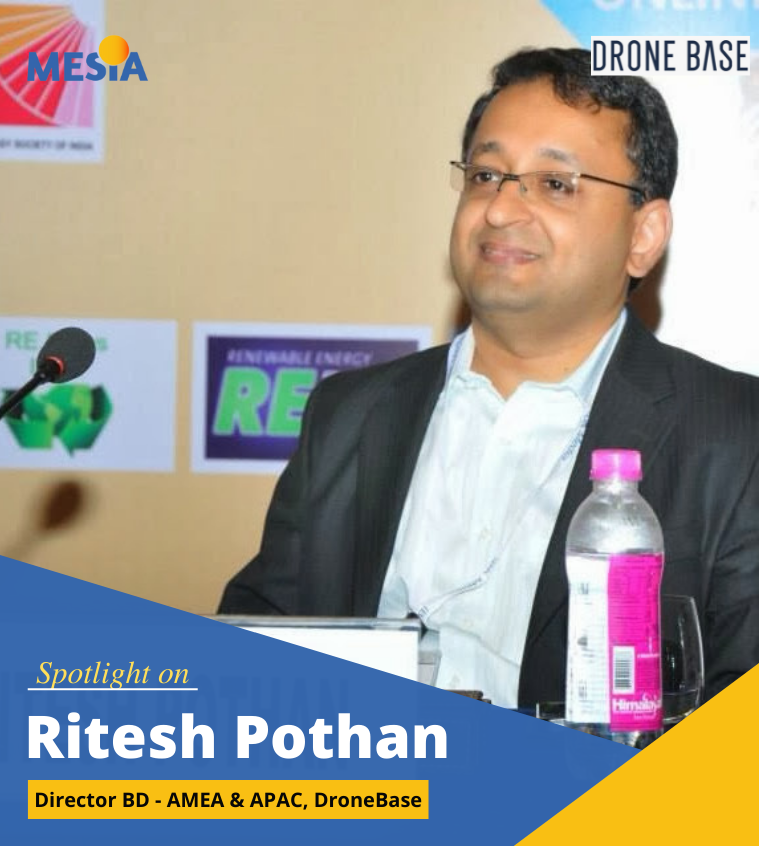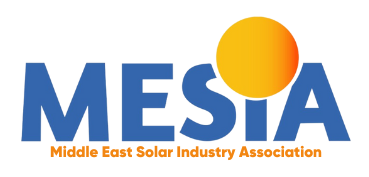Spotlight on Ritesh Pothan, Director BD – AMEA & APAC at DroneBase

Please describe your role at Drone Base and your expertise in the sector.
My role is to nurture existing markets by managing Client Relationships in AMEA and APAC.
Started off running a Renewable Advisory firm from 2009 till 2017 involved in multiple M&A’s for Solar, Wind and Biomass, then moved on to be the global business lead for Scorpius Trackers, a technology leader in Single Axis PV Tracking.
Post March 2022, now focused on construction and asset optimization for multiple domains with DroneBase, a technology global leader in Intelligent Imaging primarily focused on renewables.
How did your story in renewables begin and in your opinion, how much has it changed since then, if at all?
The initial decade of my career was spent building out the infrastructure for a global KPO serving top banks in N.A. and Europe with a team of 100+ Engineers from diverse fields of Information Security, IT Networking, Mechanical, and Civil.
Towards 2010, I founded an Advisory firm that specialized in Wind, Solar and Energy Plantations. 2009 to 2017 was spent enabling global firms access to Markets in Wind, Biomass, and Solar.
In addition to running the advisory, I started a couple of LinkedIn Renewable Groups which have grown significantly (Solar Now and Renewable) with over 30,000 members collectively, and my blog Now.Solar and writing for international magazines.
2017 onwards, I lead Global BD for Technology leader in Solar PV Single Axis Tracking – Scorpius Trackers with installations in Saudi, Kenya, Lebanon, Japan as well as India amongst other geographies where I was instrumental in building out large Solar PV projects in Saudi, India as a Lead for Projects too.
Earlier this year moved to DB to pursue my passion for improving quality in Solar PV by leading the construction monitoring globally and leading the BD for asset inspections across AMEA + APAC in all verticals
The Change
Over the last decade, saw Solar PV engineering being optimized in ways that were not recommended due to the sheer pricing pressure in certain geographies with quality being a key area, this concerned me quite a bit and I lead a team of industry experts to recommend standards to the government in 2021. LINK
Solar over the last decade has evolved rapidly from the initial focus on CSP/CPV to a primarily PV-based industry. The early days were tremendous learning opportunities and very interesting times. The idiom – (May you live in Interesting times) was quite apt for the Solar Industry from 2009-2016. In the last 5 years, the industry has focused on PV purely due to the ease of design, installation, and availability plus fast dropping prices but post-COVID that has hit a wall with prices now moving north.
Now storage, hydrogen, and others are fast-growing segments further pushing the growth of Solar PV and Wind forward. Multi GW projects are the new normal, especially in Saudi and Oman, which have shown interest in leading this space.
Can you tell us about your most advanced sector (solution/ service) and what sets you apart from other competitors?
We scan entire assets in certain geographies using manned aircraft, providing inspection results in a timeline unheard of within the industry.
DB’s AI platform is the market leader in Solar and Wind Inspections and has delivered intelligent insights on more than 70GW inspections for Solar, Wind and is also a market leader in T&D, Real Estate, and Telecom.
All DB solutions are AI-based with the ability to cover multiple renewable asset classes, DB covers the entire solar imaging lifecycle right from Identifying land patterns, mapping the water flow, monitoring construction for business owners as well as lenders, for inspections of panels using thermography for O&M and during Acquisitions to speed up the entire process.
Wind O&M is a high-risk activity given the structural safety issues going around with inspections for turbines and towers are a key requirement for compliance across geographies. DB has inspected 30,000+ turbines globally and is a key service provider for some of the top OEMs in the EU, Americas, Taiwan, Vietnam, Australia, and many other countries.
Our offerings in T&D, Telecom, and Real Estate have been extensively used for almost ~10 years delivering much-needed business intelligence for these sectors across continents.
What’s a recent milestone Drone Base has achieved that you would like to share with us?
We have crossed 70GW in renewable inspections this year, in addition to that, we acquired UK-based Transmission2 early this year which allows wider access to EU markets with a complete Deep Learning / AI platform for transmission towers and telecom along with AirProbe, a regional leader in thermography and construction monitoring in APAC including Australia.
We have also covered 2.7GW in solar inspections in 1 day which is an industry first.
What are your expectations for the MENA region in terms of growth and new opportunities for Drone Base?
MENA has tremendous potential for renewables; DB believes this region is a thought leader for the coming future with Solar and Wind delivering a large portion of the energy share replacing oil as a key source of energy. With Hydrogen being a game-changer combined with renewables used as power sources, the future for MENA is very bright.
Energy generation using solar technology is much higher than in similar latitudes globally due to higher DNI plus huge swaths of desert land suitable for deployment without usurping existing agricultural farms as in most geographies. Large solar plants can cool surroundings and increase rain yields per some studies as long as there is a suitable balance maintained, the growth of renewables is a given in MENA.
Some developers are each looking to deploy between 2-4GW each in Solar+Wind Hybrids to generate hydrogen, pushing GCC to the forefront of hydrogen using Hybrid renewable tech.
You have published an article about why combining manned aircraft and drones is the way forward. Can you please expound on this?
Drones are great at data acquisition for single locations but have lower resolution thermal sensors due to cooling needs; if you need to do multiple locations quickly and more accurately, planes fitted with high resolution, liquid-cooled thermal sensors are far more suitable for the task. In North America, we use specially outfitted manned aircraft to capture entire routes from east to the west coast and complete states as well twice a year.
Our aircraft can capture more than 1 GWp/day vs 30MWp/Day using drones, delivering quick, cost-effective and efficient solutions to our clients by reducing weeks for a single site to a single day.
Something which would take about 15+ days in total including data capture + data analysis is now driven down to a few hours due to the fact that when we run the piloted aircraft over the farm, we scan entire solar farms within that geography.
In addition, we rank sites based on performance which allows owners to focus on those sites which are not performing.
Currently twice a year, DB scans the US EW bus routes which cover all the solar farms under those particular routes from East Coast to West Coast in the US and we are looking to expand this to Europe, Asia as well as Australia. We have recently scanned all the assets in a state totaling to 20GW and have introduced the Industry 1st Solar Asset Ranking System.
This is a game changer for the industry wherein you can actually check your portfolio vis a vis the industry, rank the performance, figure out which are the panels which are working better, which plants design is the best design and much more. This helps tremendously when you are managing a quite a few gigawatts across the globe.
Our focus is on Developers as well as owners who are growing and looking for global support partners for business intelligence in imaging
Why is good O&M necessary with the technology deployed currently
Studies within the industry show that plants are not performing to the levels that they have been designed for. P50 estimates have not delivered and even P90 numbers are a struggle.
Optimizing a plant is of crucial value, performance recoveries we have seen vary between 1% to 7% and more, depending on the design, quality of material and install. There are also further improvements that can be focused on during commissioning. Improving safety is a further benefit of using the platform which identifies areas prone to fire due to vegetation.
While immense focus is on design, good O&M is a key aspect of the future of solar energy and energy saved is energy generated. Just 1% improvement in global generation translates to a recovery of 10GW of renewable energy assets globally.
Do the math!
